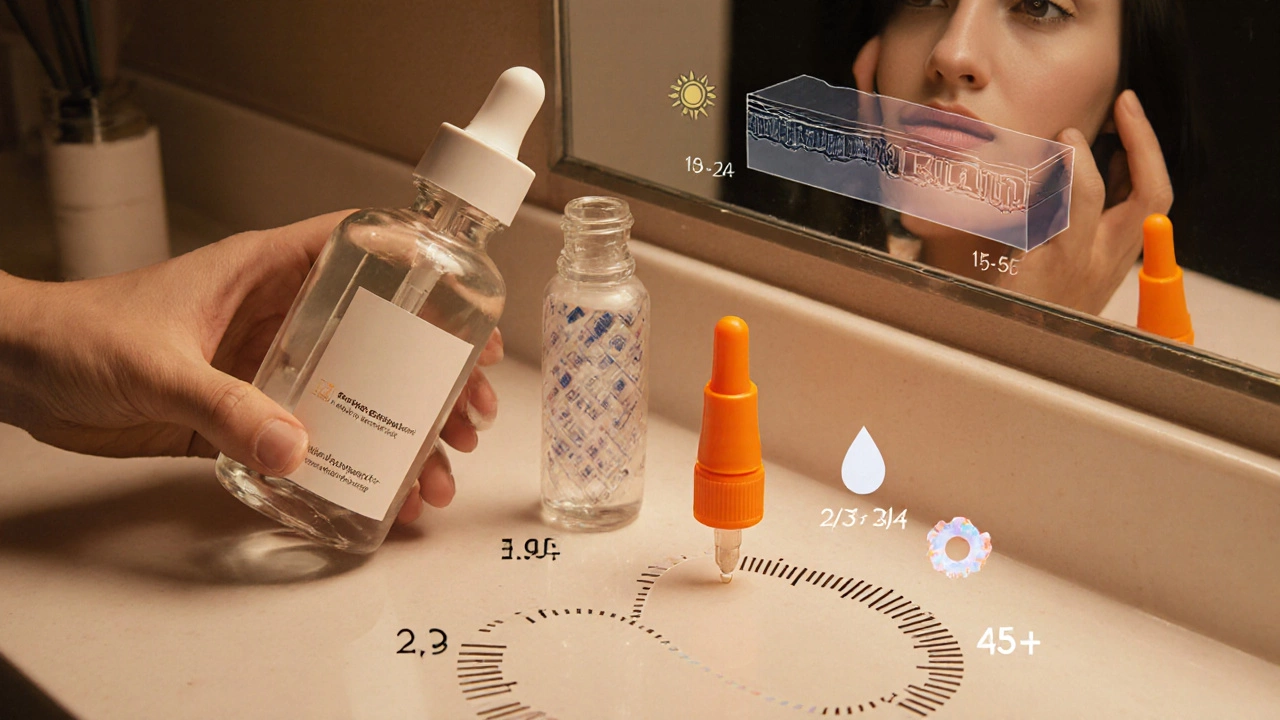Skin Aging Calculator
Identify Your Skin Aging Stage
Enter your age to see which period of accelerated skin aging you're currently in and get personalized skincare recommendations.
Your Skin Aging Stage
Ever caught yourself looking in the mirror and thinking, “Why does my skin look older than my years?” You’re not alone. Understanding skin aging is the gradual decline in skin’s structural proteins, moisture retention, and barrier function that makes us look older over time. Pinpointing the period when this process spikes can help you target the right anti‑aging treatments before the damage sets in. Below we break down the ages when you age the fastest, why those windows exist, and what you can do about them.
Why Some Years Feel Like Time Speeds Up
Age is more than a number on a birthday cake; it’s a cascade of biological events. Hormone fluctuations, collagen turnover, and environmental exposure each have their own timetable. When these factors line up, they create a perfect storm that makes the skin appear to “jump” a decade in a few short years.
- Hormonal surges in the late teens trigger acne, inflammation, and subtle scar formation.
- From the mid‑20s onward, Collagen production drops by roughly 1% each year, weakening the dermal scaffold.
- Mid‑40s hormonal shifts-especially the drop in estrogen during Menopause-strip the skin of moisture‑binding proteins.
- Chronic exposure to UV radiation and Free radicals accelerates DNA damage, leading to uneven tone and loss of elasticity.
When you know which clock is ticking, you can set the alarm for prevention.
Age Windows When Skin Ages the Fastest
Research from the International Dermal Institute (2024) shows three distinct periods where the rate of visible aging spikes. The table below summarizes the age range, the primary biological driver, and the most effective intervention.
| Age Range | Key Aging Driver | Top Anti‑Aging Intervention |
|---|---|---|
| 18‑24 | Hormonal changes & acne inflammation | Gentle niacinamide serum + non‑comedogenic sunscreen |
| 25‑34 | Collagen loss (≈1% per year) | Retinol 0.3%‑0.5% night cream + peptide serum |
| 35‑44 | Reduced elastin & early UV‑induced damage | Broad‑spectrum SPF 30+ + antioxidant vitamin C serum |
| 45‑55 | Menopause‑related estrogen drop | Hyaluronic acid boosters + peptide‑rich moisturizers |
| 55+ | Cumulative oxidative stress & dermal thinning | Laser resurfacing or micro‑needling + retinoid + peptides |
Notice how each period leans on a different mix of ingredients. That’s because the underlying cause shifts, and a one‑size‑fits‑all routine won’t cut it.
Key Biological Drivers Behind Rapid Aging
Let’s dig deeper into the five main culprits that power the fastest aging age spikes.
- Collagen depletion - The primary structural protein that gives skin its firmness. After age 25, fibroblasts synthesize 1% less collagen per year.
- Elastin degradation - Responsible for skin’s ability to snap back. UV‑induced matrix metalloproteinases (MMPs) break down elastin fibers, especially after repeated sun exposure.
- Hormonal fluctuations - Teen‑age hormone surges fuel acne; perimenopause lowers estrogen, reducing hyaluronic‑acid production and making skin dry.
- Free radical damage - Reactive oxygen species (ROS) from pollution, smoking, and stress oxidize lipids and proteins, accelerating wrinkles.
- UV radiation - UVA penetrates deep, causing DNA cross‑links; UVB creates sunburn and melanin spikes, both leading to uneven texture.
Targeting each driver with the right actives can dramatically slow the clock.

How Lifestyle Accelerates or Slows the Clock
Even the best serums can’t fully offset unhealthy habits. Here’s a quick reality check.
- Smoking introduces thousands of free radicals per cigarette, cutting collagen synthesis in half.
- Diet high in sugar triggers advanced glycation end‑products (AGEs) that stiffen collagen fibers.
- Chronic stress spikes cortisol, which degrades collagen and impairs barrier repair.
- Sleep deprivation reduces growth hormone release, slowing tissue regeneration.
- Inadequate hydration leads to reduced skin turgor, making fine lines more visible.
Swap a night out for a 7‑hour sleep, and you’ll likely see smoother skin in weeks, not years.
Top Anti‑Aging Interventions for Each Critical Age
Below you’ll find the most evidence‑backed treatments tailored to each fast‑aging window. Use the table above as a roadmap.
Late Teens (18‑24)
- Niacinamide 5% - reduces inflammation and strengthens the barrier.
- Low‑strength Retinol (0.1%) - promotes cell turnover without irritation.
- Broad‑spectrum SPF 30+ - daily use prevents UV‑induced collagen breakdown.
Mid‑20s to Early‑30s (25‑34)
- Retinol 0.3%‑0.5% - stimulates new collagen fibers.
- Peptide serums (e.g., Matrixyl, Argireline) - signal fibroblasts to rebuild elastin.
- Vitamin C 15% - neutralizes free radicals and brightens tone.
Late 30s to Early 40s (35‑44)
- Broad‑spectrum SPF 50+ - highest protection against UVA‑induced elastin loss.
- Antioxidant cocktails (Vitamin E, Ferulic Acid) - reinforce Vitamin C’s protective effect.
- Hyaluronic Acid fillers - restore lost volume and improve hydration.
Mid‑40s to Mid‑50s (45‑55)
- Growth factor creams - encourage cell renewal during hormonal decline.
- Peptide‑rich moisturizers - maintain elasticity as estrogen wanes.
- Professional Laser resurfacing - stimulates deep collagen remodeling.
55 and Beyond
- Micro‑needling combined with topical retinoids - creates controlled micro‑injuries that trigger robust collagen response.
- Dermal fillers (e.g., hyaluronic acid, calcium hydroxylapatite) - address deep volume loss.
- Regular antioxidant‑rich diet (berries, leafy greens) - combats cumulative oxidative stress.

Quick Checklist: Spotting Early Signs of Accelerated Aging
- Fine lines around eyes and mouth appear before age 30. \n
- Loss of skin firmness on the jawline or cheeks.
- Uneven pigmentation or sunspots developing before 40.
- Increased dryness despite regular moisturization.
- Visible throat or décolletage lines that mirror facial aging.
If you tick more than two of these boxes, consider upping your anti‑aging arsenal now.
Common Pitfalls to Avoid
Even seasoned skincare fans slip up. Here’s what not to do.
- Skipping sunscreen on cloudy days - UV‑B penetrates cloud cover.
- Mixing high‑strength retinol with vitamin C in the same routine - can cause irritation.
- Relying solely on over‑the‑counter moisturizers without actives - moisturizers hydrate but don’t rebuild collagen.
- Using harsh scrubs to “exfoliate away” wrinkles - mechanical abrasion damages the barrier.
- Ignoring professional advice - a dermatologist can tailor treatment to your specific hormonal profile.
Putting It All Together: Your Personalized Anti‑Aging Roadmap
Start by identifying which age bracket you’re currently in. Then match the top three interventions from the list above to your routine. Track progress with monthly photos and adjust ingredients based on skin response. Consistency beats occasional over‑the‑top‑shelf products every time.
At what age does skin start losing collagen fastest?
Collagen production begins a noticeable decline around age 25, losing roughly 1% per year. The steepest drop occurs between 25‑34, making this the first major fast‑aging window.
Can men experience the same fast‑aging periods?
Yes. Men also face collagen loss from the mid‑20s, but they tend to skip sunscreen and have higher oil production, which can exacerbate UV‑related aging. Hormonal shifts around mid‑40s (testosterone decline) also affect moisture retention.
Is sunscreen really needed on cloudy days?
Absolutely. Up to 80% of UV‑B rays penetrate clouds. Broad‑spectrum SPF 30+ guards against both UVA (deep skin damage) and UVB (sunburn), slowing collagen breakdown year after year.
What’s the difference between retinol and prescription tretinoin?
Retinol is a milder, over‑the‑counter precursor that the skin converts to active retinoic acid. Tretinoin is already active, delivering faster results but with higher irritation risk. Beginners should start with retinol and step up under dermatologist guidance.
Do anti‑aging supplements work?
Supplements like marine collagen, Vitamin C, and CoQ10 can support skin health from the inside, but they’re not a substitute for topical actives. Pairing oral antioxidants with a solid skin‑care routine yields the best results.

